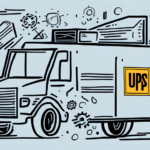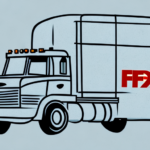Shipping Large Packages with FedEx: How to Ship Packages Over 96 Inches
Shipping large packages that exceed FedEx's standard size and weight limits can be a daunting task. Whether you're transporting machinery, furniture, or other bulky items, understanding FedEx's guidelines and best practices is essential for ensuring your packages arrive safely and on time. This comprehensive guide covers everything you need to know about shipping oversized packages with FedEx, including measuring and weighing, selecting the appropriate packaging, labeling, pricing, tracking, and more.
FedEx's Size and Weight Limits for Shipping Large Packages
Before shipping large packages with FedEx, it's crucial to understand their size and weight restrictions. FedEx categorizes packages into two main types: Standard and Oversize.
Standard Packages
- Maximum Dimensions: 96 inches in length and girth combined (girth = 2 x width + 2 x height)
- Maximum Weight: 150 pounds
Oversize Packages
- Maximum Length: 130 inches
- Maximum Girth: 165 inches
- Maximum Weight: 150 pounds
Understanding these distinctions is vital as they determine the shipping rate, required box size, and other shipping conditions. For the most accurate and up-to-date information, refer to FedEx's official Oversize Shipping Guidelines.
Measuring and Weighing Large Packages Accurately
Accurate measurement and weighing of your packages are critical to avoid unexpected charges and ensure smooth transit. Follow these steps to measure and weigh your large packages correctly:
- Use a reliable tape measure or ruler to determine the length, width, and height of the package.
- Round all measurements to the nearest inch.
- Utilize a professional-grade scale that can accurately measure up to 150 pounds.
- Account for all packaging materials, such as bubble wrap and packing peanuts, as they contribute to the overall dimensions and weight.
Including the weight and size of all packaging materials ensures that your shipment complies with FedEx's guidelines and avoids additional fees.
Selecting the Right Packaging for Oversized Shipments
Choosing the appropriate packaging is essential to protect your items during transit. Here are some tips for selecting the right shipping box for large packages:
- Use Sturdy, Corrugated Boxes: Ensure the box can withstand the weight and size of your package.
- Avoid Reused or Damaged Boxes: Opt for new boxes to prevent wear and tear from compromising the integrity of your shipment.
- Provide Adequate Cushioning: Allow sufficient space for protective materials like bubble wrap or foam to minimize movement within the box.
- Consider Custom Packaging: For irregularly shaped items, custom-sized boxes or crating may offer better protection.
For high-value or fragile items, consider double-walled boxes or specialty packaging designed for specific products to enhance protection during transit.
Packing and Securing Fragile Items
Proper packing techniques are vital to prevent damage to fragile items. Follow these guidelines to secure your valuables effectively:
- Wrap Items Individually: Use bubble wrap or packing paper to cushion each item.
- Use Packing Fillers: Fill empty spaces in the box with packing peanuts, foam, or air pillows to restrict movement.
- Label as Fragile: Clearly mark the package with "Fragile" labels to alert handlers.
- Insure Your Shipment: Consider purchasing insurance to cover potential damages or losses.
Ensuring that each item is securely packed and that the box is appropriately sized will reduce the risk of damage during handling and transit.
Proper Labeling for Large Shipments
Accurate labeling is essential for the efficient handling and delivery of your large packages. Here's what to include on your shipping label:
- Recipient's Information: Full name, address, and contact number.
- Sender's Information: Your name, address, and contact details.
- Package Details: Weight, dimensions, and any special handling instructions.
- Customs Information: For international shipments, include the recipient's country, postal code, and necessary customs declarations.
Create shipping labels using FedEx's official online tools to ensure all information is accurate and properly formatted. Utilize durable, waterproof labels and place them on a flat surface of the package to enhance visibility and durability during transit.
Understanding Pricing and Rates for Oversized Packages
Shipping large packages with FedEx involves various pricing factors, including weight, dimensions, shipping zone, delivery speed, and additional services. Here's how to navigate FedEx's pricing structure:
- Rate Calculator: Use FedEx's Rate Calculator to estimate shipping costs based on your package details.
- Volume Discounts: Businesses shipping large volumes may qualify for discounted rates. Contact FedEx directly to inquire about bulk shipping discounts.
- Shipping Options: FedEx offers various services such as freight shipping and white glove delivery, which may include additional fees but provide specialized handling.
Comparing different shipping options and understanding the associated costs can help you choose the most cost-effective and efficient method for your needs.
Tracking and Managing Your Shipment
FedEx provides robust tracking tools to monitor the status of your large package shipments:
- Online Tracking: Use the FedEx Tracking Tool to get real-time updates on your package's location and estimated delivery time.
- FedEx Delivery Manager: Customize delivery options, receive notifications, and manage delivery preferences through FedEx's Delivery Manager.
- Customer Support: Contact FedEx's customer service for assistance with tracking issues or to obtain detailed shipment information.
Effective tracking helps ensure transparency and allows you to address any potential issues promptly.
Avoiding Common Mistakes When Shipping Large Packages
Shipping oversized packages can be complex, and avoiding common pitfalls is essential for a smooth experience. Here are some mistakes to steer clear of:
- Inaccurate Measurements: Double-check all measurements and weights to prevent unexpected charges.
- Poor Packaging: Use appropriate materials and techniques to protect your items.
- Incorrect Labeling: Ensure all shipping labels are accurate and clearly visible.
- Neglecting Insurance: Insure valuable or fragile items to safeguard against potential losses.
- Ignoring Delivery Instructions: Coordinate with recipients regarding delivery preferences and signature requirements.
- Shipping Restricted Items: Verify that your package doesn't contain prohibited or restricted items by reviewing FedEx's Prohibited and Restricted Items List.
By being aware of these common mistakes, you can enhance the efficiency and reliability of your shipping process.
Filing Claims for Damaged or Lost Shipments
Despite careful preparation, packages may sometimes be damaged or lost during transit. Here's how to handle such situations with FedEx:
- Gather Documentation: Collect the original shipping label, invoice, evidence of the package's value, and any photos or proof of damage.
- Submit a Claim: File a claim online through FedEx's Claims Center or contact customer service for assistance.
- Follow Up: Monitor the status of your claim and provide any additional information as requested by FedEx.
Timely and accurate claims submission increases the likelihood of a successful resolution.
International Shipping of Large Packages with FedEx
Shipping oversized packages internationally involves additional considerations, such as customs clearance and documentation:
- Customs Forms: Accurately complete all required customs documentation to avoid delays and additional charges.
- Regulatory Compliance: Ensure your package complies with the destination country's import regulations and restrictions.
- Tariffs and Duties: Be aware of potential tariffs and duties that may apply to your shipment.
For detailed guidance, refer to FedEx's International Shipping Information or consult with FedEx customer support.
Best Practices for Shipping Multiple Large Packages
When handling multiple large shipments, efficiency and organization can significantly impact your shipping experience:
- Organize Shipments: Create a detailed plan outlining the weight, dimensions, and destinations of each package.
- Batch Processing: Group similar shipments to streamline packaging and labeling processes.
- Utilize Tracking Systems: Implement a labeling and tracking system to monitor each package's status effectively.
- Leverage Volume Discounts: Negotiate with FedEx for volume-based discounts to reduce overall shipping costs.
- Coordinate with Recipients: Ensure recipients are prepared to receive multiple packages, minimizing the risk of missed deliveries.
Adopting these best practices can enhance the efficiency, accuracy, and cost-effectiveness of your large package shipments.
Comparing FedEx's Large Package Services to Other Carriers
While FedEx offers robust services for shipping large packages, it's beneficial to compare offerings with other carriers to determine the best fit for your needs:
- UPS: Offers similar size and weight limits with additional services like UPS Freight.
- United States Postal Service (USPS): Generally handles smaller oversized packages but may be limited for very large shipments.
- DHL: Specializes in international shipping with comprehensive global coverage.
Evaluate factors such as pricing, delivery speed, service coverage, and additional features to choose the carrier that best aligns with your shipping requirements.
Conclusion
Shipping large packages with FedEx requires careful planning, accurate measurements, appropriate packaging, and a clear understanding of FedEx's policies and services. By following the guidelines and best practices outlined in this guide, you can navigate the complexities of shipping oversized items with confidence, ensuring your packages arrive safely and efficiently. Always stay informed about the latest shipping regulations and leverage FedEx's resources to optimize your shipping strategy.




















